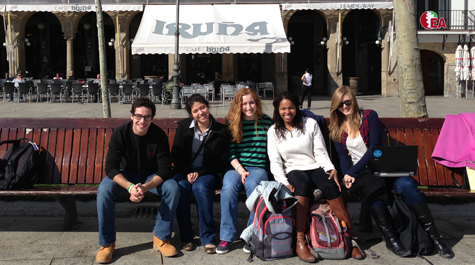From the courts of 17th-century Spain
Domestic violence. Drug smuggling. Priests hauled into court for scandalous behavior. Welcome to Spain in the 17th century.
Historian Lu Ann Homza took five students to Pamplona, Spain over spring break to study handwritten manuscripts of court cases from the 1600s that dealt with such matters. These William & Mary students had one week to sift through documented court records written in an archaic form of Spanish, as well as in handwriting that at times was nearly impossible to read.
The five—Sagra Alvarado ’15, Jessie Dzura ’13, Crosby Enright ’14, Tracey Johnson ’14 and Jack Middough ’15—had come to Pamplona prepared. They spent the fall semester in a specialized class with Homza, learning how to decode the 400-year-old Spanish they would have to deal with in the Pamplona archives. Read about their preparation here.
The first thing the students started working with in their preparation period were typed transcripts of the original manuscripts. Homza explained that the students needed to learn the unfamiliar forms and conventions of Spanish legalese before tackling the additional challenges of the centuries-old penmanship that awaited them in the archives of Pamplona. It’s the same sort of preparation necessary for professional historians.
“History is interpretation,” says Homza. “And this trip is true to life in terms of what historians do.”
When spring break arrived, it was time for the students to depart. Some took exams early, some had to work late into the night before the flight, but all five arrived in Spain ready to work on their unique research topics. Topics included everything from spousal abuse to a class of economically empowered widows.
“I found three cases of women who were tobacco smugglers,” says Alvarado who began with a desire to research contraband. “I was reading about the process: where did they get it, where did they hide it.”
Alvarado explained that because tobacco was a state enterprise, any illicit product is essentially black market. The details she continues were hard to get to, as her manuscripts’ handwriting was particularly difficult to read.
Johnson, on the other hand, had less of a problem with the handwriting of her documents. She discovered a previously unknown role of women in Spanish society as forces within the local economy.
“I looked at old notario records,” she says, explaining that a notario is what we would understand as a public notary. “I found a lot of old contracts of widows dealing with money and making loans to other people”
The veteran of the trip, Enright chose to expand on her previous work with rogue nuns.
“I did a twist on my misbehaving nuns and did misbehaving priests, priests who would dance in the streets, play instruments and put on theatre” she says, explaining that the priests were taken to court for neglecting their sacred duties in favor of music and theatre.
Another student chose to research the role of religious conjuring in Spanish society. Middough says his cases involved priests who were hired as conjurors, one to banish a worm infestation and one to bring about a rainstorm for the crops. His cases ended up in court for different reasons. The worm wizard went to court because he wasn’t paid at all. The rainmaker, by contrast, was paid in advance; he simply ran off with the money to spend on drinks, women and gambling.
Dzura’s research focused on domestic violence at first, and then evolved into a study of acceptable reasons for ending a marriage.
“My topic started off as violence against women in the 17th century,” says Dzura. “It evolved into an interest of ‘bad treatments’ in marriage and what it took for the courts to recognize reasons for divorce.”
Difficult handwriting and strange syntax usages were not the only problems that these students faced. Homza points out that the content of these cases was confusing in its own right.
“Sometimes the cases are so enormous you get into them and you get lost, you’re not sure what you’re reading by whom” says Homza. “It’s not as if there are little subsections with sticky notes telling you what comes next.”
Students may not have sticky notes, but they do have the help and support of the archivists who are able to lend a helping hand or even just a word of encouragement. That’s why Homza and her students made it a point to catch up with retired archivist, mentor, and friend Don Jose Luis Sales Tirapiu before departing Spain. Tirapiu is credited with building the Archivo Diocesano de Pamplona to be what it is today.
“Don Jose Luis Sales Tirapiu organized over 35 years this whole archive. We got to spend a little part of an afternoon with him,” says Homza. She has worked with Tirapiu in previous years, and says she was happy to be able to reconnect with the man behind the archive.
The students’ hard work wasn’t finished after a week of sifting through these documents however. They then returned home to start synthesizing their findings and preparing to present this research at the Annual William and Mary Undergraduate Research Symposium for Medieval and Renaissance Studies.
“The presentation solidified my Pamplona experience,” says Alvarado. “While I was presenting I was happy to share my findings with the WM community and bring these historical figures to life.”
Homza, now William & Mary’s dean for educational policy, has no plans on letting this trip fall by the wayside. She has started to recruit a new class of junior archivists, including Alvarado and Middough, who will return to Pamplona next year.
















